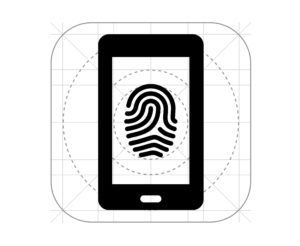While 2017’s mobile biometrics story of the year is probably Apple’s Face ID system – at least as far as media attention goes – another one has been developing under the surface. Literally.
 The Quest for In-Display Tech
The Quest for In-Display Tech
Putting a functional fingerprint sensor under the screen of a mobile device has in fact been a technological pursuit in the mobile industry since last year, with signs of success starting to emerge that autumn, when Fingerprint Cards announced that it had implemented a fingerprint sensor under the cover glass of a new Huawei smartphone. It wasn’t in the display, of course, but it certainly pointed in that direction.
Then came the first big announcements of in-display fingerprint sensor technology. Goodix claimed the world’s first at Mobile World Congress in Feburary, and Qualcomm followed that up in June with its announcement of ultrasonic fingerprint sensors that can scan through glass, metal, and mobile displays.

A Quiet Summer
Then there was silence. Goodix did not follow up its splashy MWC announcement with any integrations of in-display technology, and for its part Qualcomm said its in-display sensors wouldn’t be available to OEMs until Q4. Over the summer, rumor after rumor pointed to in-display fingerprint sensor technology Samsung’s new Note 8 smartphone and Apple’s next big iPhone. It never materialized; and indeed, there’s a strong case to be made that while Apple tried to develop in-display technology for the iPhone, it ultimately couldn’t make it viable for its production schedule.
The Goods
 But now it appears that technology that eluded the two biggest names in smartphones is finally emerging. At the start of November, one of the biggest biometrics suppliers in the mobile business, Fingerprint Cards, announced that it had developed viable in-display ultrasonic fingerprint sensor technology, and suggested it would work with customers to bring it to market in the first half of 2018. And this month, fingerprint sensor specialist Synaptics announced that its in-display optical sensor technology has gone into mass production, and would be demonstrated in a ‘Tier 1’ smartphone at January’s Consumer Electronics Show. Language used in the press release, together with other circumstantial evidence, even has some wondering if that device will be Samsung’s flagship Galaxy S9 smartphone, which could make quite a splash. Qualcomm, meanwhile, has been quiet on this front, but it’s fair to expect some kind of in-display sensor announcement from the company soon, given the timeline it offered for its technology earlier this year.
But now it appears that technology that eluded the two biggest names in smartphones is finally emerging. At the start of November, one of the biggest biometrics suppliers in the mobile business, Fingerprint Cards, announced that it had developed viable in-display ultrasonic fingerprint sensor technology, and suggested it would work with customers to bring it to market in the first half of 2018. And this month, fingerprint sensor specialist Synaptics announced that its in-display optical sensor technology has gone into mass production, and would be demonstrated in a ‘Tier 1’ smartphone at January’s Consumer Electronics Show. Language used in the press release, together with other circumstantial evidence, even has some wondering if that device will be Samsung’s flagship Galaxy S9 smartphone, which could make quite a splash. Qualcomm, meanwhile, has been quiet on this front, but it’s fair to expect some kind of in-display sensor announcement from the company soon, given the timeline it offered for its technology earlier this year.
Of course, for the average consumer, none of this is really big news. Big news would be an actual smartphone that can scan your finger on its screen. But that’s what all this behind-the-scenes activity points to – and soon.
—
December 14, 2017 – by Alex Perala


Follow Us